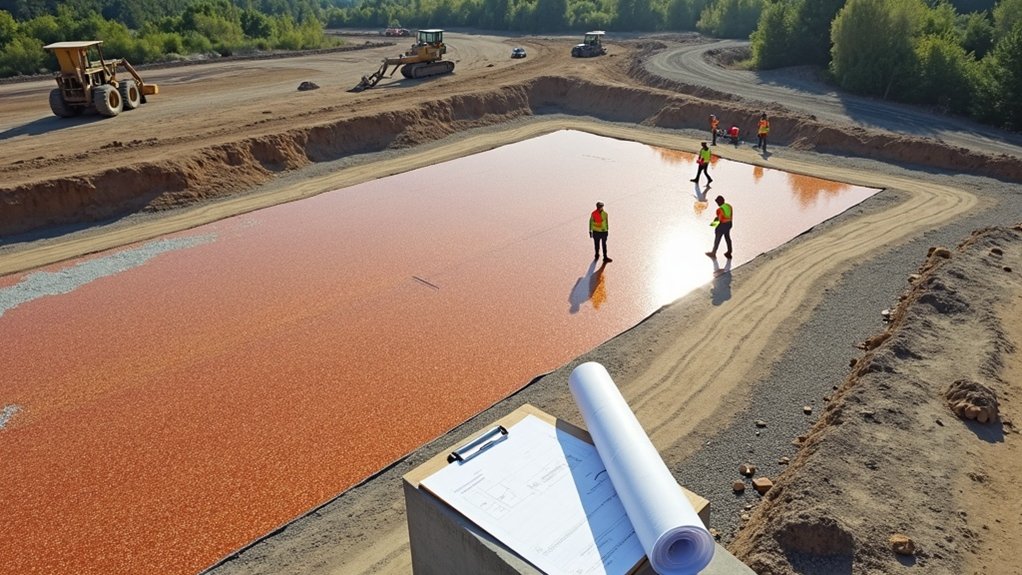Before installing large resin-bound gravel surfaces, check your local council’s planning rules. Most areas over 5m² require proper permissions, though many councils don’t need them for permeable surfaces like resin-bound gravel. Your project must follow SuDS guidelines to manage rainwater properly – this means ensuring water can drain naturally through the surface rather than running off onto roads or neighbouring properties.
Contact your local planning office early on, as requirements vary between councils. Some areas, particularly conservation zones or listed buildings, have stricter rules. Keep all paperwork, including supplier details and installation specs, as you might need these later to prove compliance.
Key Takeaways
Planning Rules for Large Resin-Bound Surfaces
Installations over 5m² might need planning approval, particularly to meet local drainage requirements (SuDS). Most councils view resin-bound surfaces as permitted development, meaning you won’t usually need permission thanks to their water-permeable nature.
For bigger projects like double driveways, it’s worth checking with your local council first – rules vary across different areas. You’ll need proper drainage plans and permeability tests to show your installation won’t cause flooding issues.
Listed buildings or homes in flood-prone areas face stricter rules. In these cases, you’ll likely need special permission and may have to install additional drainage.
Top tip: Before starting any large resin-bound project, pop down to your local planning office or check their website – it could save you headaches later.
Understanding Resin-Bound Gravel

Resin-bound gravel delivers both style and practicality for outdoor surfaces.
It’s made by mixing natural stone with a clear polyurethane resin, much like coating pebbles in strong glue. Installation needs a solid base – usually tarmac or concrete – where installers hand-trowel the mixture to create a smooth finish, similar to icing a cake. This method creates a surface that lasts between 15-20 years, providing long-term value for garden planning.
Unlike its cousin, resin-bonded gravel, this method fully coats each stone, making it far more durable. The surface depth ranges from 12-24mm, perfect for driveways, paths and patios. It’s UV-resistant, so it won’t yellow in the sun, and water drains straight through it – brilliant for avoiding puddles during British weather. These qualities make it a top choice for home gardens and business premises alike. Additionally, its permeability allows for effective rainwater drainage, enhancing sustainability in outdoor designs.
The finish looks smart and stays put, unlike loose gravel that ends up everywhere. Think of it as permanent gravel that you never need to rake back into place.
Permissible Surface Areas
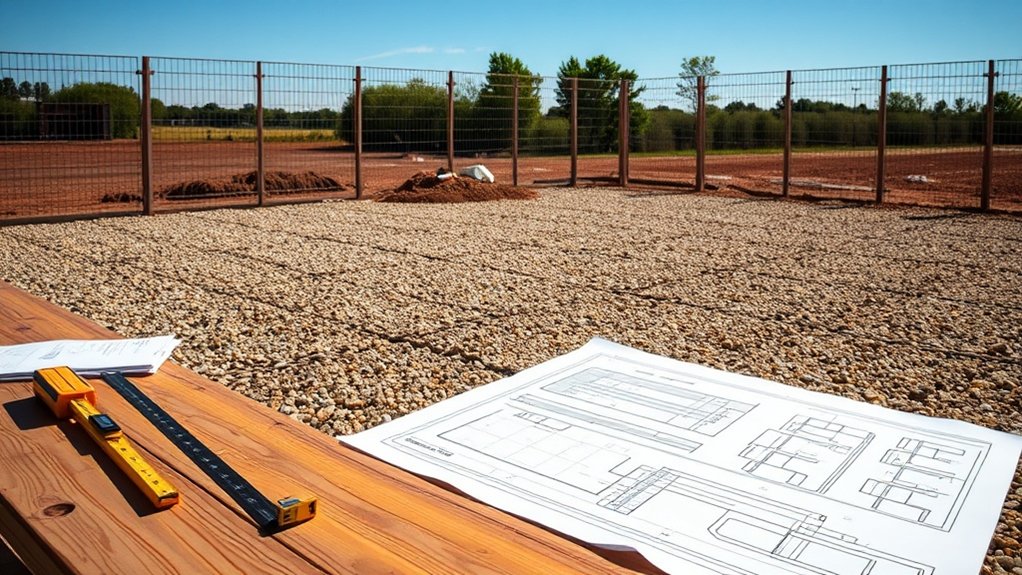
Surface Area Guidelines for Resin Driveways
For resin-bound gravel surfaces in the UK, size and drainage requirements must meet local planning rules.
Any area over 5m² requires proper SuDS compliance to manage rainwater effectively. Before starting your project, check with your local council, as permissions may be needed for larger installations. Ensuring your surface meets natural drainage standards helps prevent localised flooding and supports environmental protection. It’s important to remember that compliance with Sustainable Drainage Systems (SuDS) requirements is vital for effective drainage management.
A typical single parking space (2.4m x 4.8m) sits under the 5m² limit, whilst a double driveway would need planning consideration.
Planning tips:
- Measure your area carefully
- Consider drainage patterns
- Check local authority guidelines
- Factor in surrounding garden space
Surface Area Regulations
Surface area rules matter when installing permeable surfaces like resin-bound gravel in the UK. You’ll need to work out exact measurements to check if you need planning permission. Most resin-bound driveways get the green light without permission as they let water drain through naturally. For traditional non-porous surfaces, you must get permission if the area is larger than five square metres, unless water drains into a permeable area nearby. Each council has its own specific rules, so it’s worth checking with your local planning office before starting work. Getting advice early helps avoid headaches down the line. For example, a typical front garden conversion to a driveway might need different permissions depending on your location and chosen materials. Additionally, complying with Sustainable Urban Drainage Systems (SuDS) guidelines is essential to effectively manage surface water. Remember: getting these details sorted at the start makes the whole project smoother and keeps you on the right side of environmental regulations. The popularity of resin bound paving is also due to its ability to manage surface water run-off effectively.
Compliance With Suds Standards
Complying with SuDS standards is vital when installing resin-bound gravel.
You’ll need to consider your local drainage patterns and use permeable materials like MOT Type 3 aggregate for the sub-base. Standard concrete won’t work as it blocks water drainage.
Keep your resin-to-aggregate mix between 6.5-7.5%. For depth, you’ll want at least 15mm for paths and 18mm for driveways.
Following FeRFA guidelines during installation will ensure your surface drains properly and lasts longer.
Choose BBA-certified products – they’re tested for UK conditions and will help prevent flooding whilst protecting the environment.
This approach ticks all the boxes for both planning requirements and practical performance.
Planning Permission Exemptions

Resin-bound gravel usually doesn’t need planning permission in the UK, mainly because it’s permeable and lets rainwater drain naturally.
Most councils classify it as permitted development, especially for driveways and paths.
That said, you’ll want to check your local authority’s rules if you’re planning to cover a large area or if your property has special restrictions (like listed building status).
A quick ring to your council’s planning department can confirm whether you need permission for your specific project.
Permeability Benefits Explained
The benefits of permeable paving are clear when it comes to planning rules for resin-bound gravel. These surfaces let most rainwater soak through – up to 95% – which means far less water running off into drains.
Think of it as a built-in drainage system that stops puddles forming and soil washing away.
For UK homeowners, this natural drainage is particularly valuable. It takes pressure off our often-strained local sewers and helps replenish groundwater levels.
Better still, because these surfaces meet Sustainable Urban Drainage Systems (SuDS) standards, you typically won’t need planning permission to install them.
Non-permeable surfaces, like concrete, usually require council approval since they increase flood risks.
By choosing resin-bound gravel, you’re not just making your driveway or patio look smart – you’re helping tackle local flooding issues and supporting sustainable drainage.
It’s especially useful for larger areas like car parks or commercial spaces where water management is crucial.
Local Authority Variations
Local Authority Planning Rules for Resin Driveways
Different councils across the UK handle planning permission for resin-bound gravel surfaces differently. Whilst most don’t require permission for permeable surfaces, it’s worth checking your local rules before starting work.
| Local Authority | Planning Permission Requirement | Notes |
|---|---|---|
| Wigan & Leigh | Exempt | Recognised as SUDS-compliant |
| Hartlepool | Exempt | If permeability criteria met |
| Urban Councils | Case-by-case | May need extra checks |
Pop into your local planning office or check their website to confirm requirements for your area. A quick check now could save hassle later.
Surface Area Limitations
Surface area rules for resin-bound gravel are straightforward in the UK. Any new impermeable surface over 5 square metres requires planning permission.
However, you’ll likely avoid these restrictions when using permeable resin-bound materials, as they comply with SuDS drainage standards.
Think of it like this: a typical family car parking space is about 12 square metres. With permeable resin-bound gravel, you could install a double driveway without needing permission, whereas traditional concrete would require council approval.
Do check with your local council first, as some areas have stricter rules, particularly for listed buildings or conservation zones. Local authorities often have specific guidelines based on your property type and location.
The key is choosing the right material – permeable surfaces give you more flexibility with size whilst helping prevent localised flooding.
Sustainable Drainage Systems (SuDS) Explained
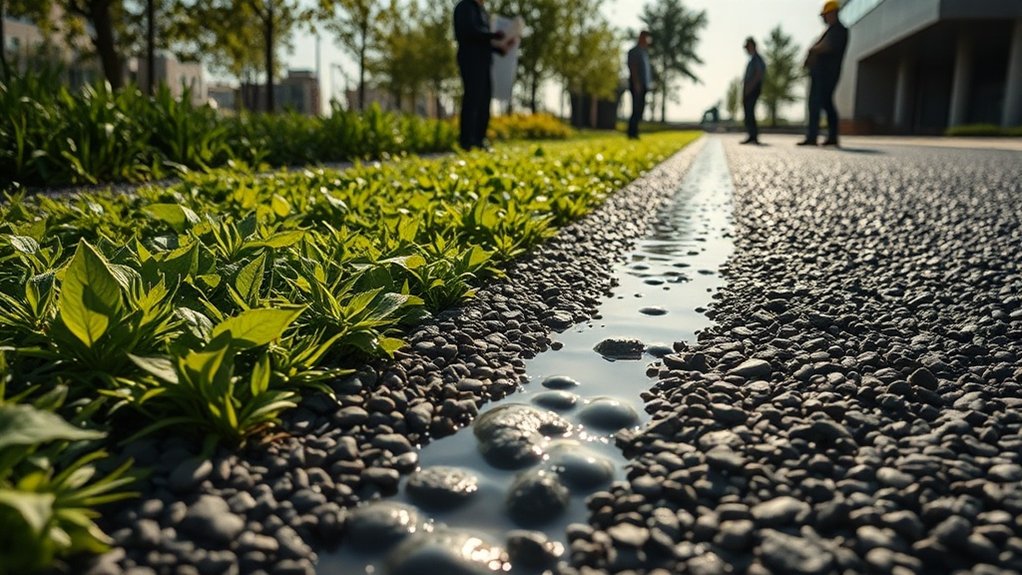
Sustainable Drainage Systems (SuDS) manage rainwater naturally, helping prevent flooding and pollution across UK towns and cities. These systems work by copying nature’s drainage patterns through practical features you might spot in your neighbourhood.
| SUDS Components | Benefits |
|---|---|
| Permeable paving | Flood risk reduction |
| Green roofs | Pollution control |
| Swales | Biodiversity enhancement |
Each SuDS project needs careful planning based on local conditions – what works for a housing estate in Manchester might not suit a retail park in Brighton. Regular maintenance is crucial; blocked permeable paving or overgrown swales won’t do their job properly. Whilst finding space in built-up areas can be tricky, and some soils aren’t suitable, well-designed SuDS create better urban spaces and smarter water management for British communities.
Local Authority Guidelines
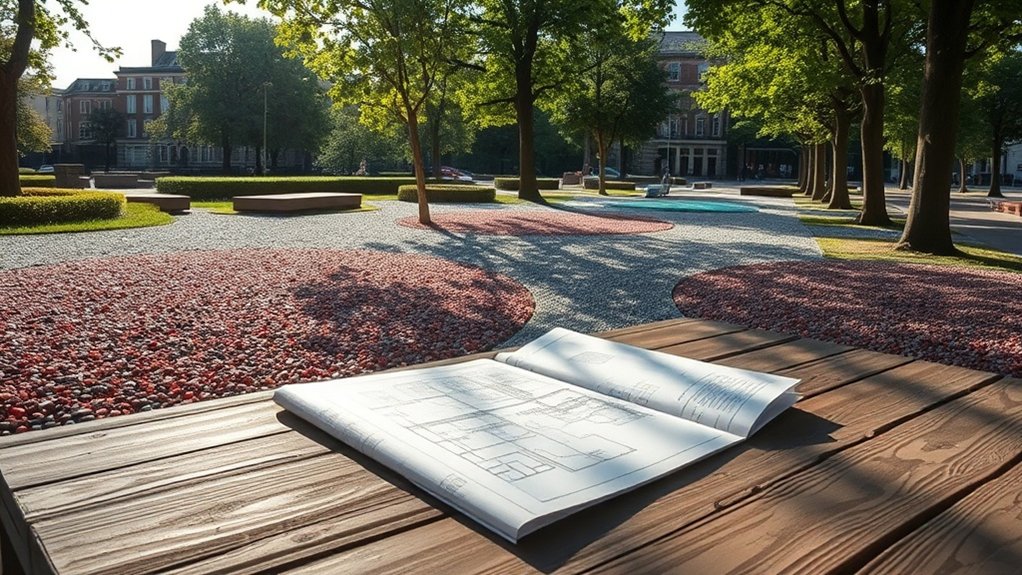
Planning rules for resin-bound driveways vary across UK councils.
If your home sits within a conservation area, you’ll likely face stricter controls.
Check with your local authority and gather all required paperwork before starting work – this might include planning permission for non-permeable surfaces over 5 square metres.
Most councils offer clear guidance through their planning portals or building control departments.
Regional Policy Variations
Regional policy variations play a vital role in resin-bound gravel installations across the UK. Local councils set different guidelines for planning permission, with many English authorities waiving requirements for permeable surfaces.
Up north, councils like Wigan and Leigh specifically approve resin-bound surfaces under SUDS regulations. City councils tend to be stricter, often requiring proof of permeability for exemptions.
Wales and Scotland follow their own rulebooks – whilst they share the UK’s focus on sustainable drainage, their specific requirements differ.
Before starting any installation, it’s worth checking your local authority’s stance, as getting it wrong could mean costly delays or rejected applications.
A quick call to your council’s planning department can save headaches later – they’ll clarify whether you need permission and what evidence you’ll need to provide.
This straightforward approach helps ensure your installation meets all local requirements from the start.
Conservation Area Restrictions
Conservation area restrictions heavily affect resin-bound gravel installations, as councils enforce strict rules to maintain these historically significant areas.
Local authorities often require traditional materials that match the neighbourhood’s character. Whilst resin-bound surfaces are typically acceptable due to their drainage benefits, bold colours or modern finishes may not get approval.
Before starting work, you’ll need planning permission and should check with your local conservation officer about suitable materials and designs.
For example, a warm-toned aggregate that matches existing York stone pavements would likely be more acceptable than a bright blue mix.
Getting proper approval ensures your installation both preserves the area’s heritage and meets current drainage standards.
This avoids costly corrections and helps maintain your property’s value within the conservation area.
Documentation Requirements Overview
Documentation Requirements for UK Resin-Bound Surfaces
UK councils require specific paperwork for resin-bound gravel installations, particularly for planning permission. You’ll need:
- Permeability reports and manufacturer specs showing drainage capabilities
- Drainage plans showing how water flows to soakaways
- Site plans with measurements for larger projects
- Water table assessments where relevant
Different rules apply depending on your property type and location. Flats and conservation areas often need extra documentation.
Check your local council’s website or speak with a planning officer to confirm exact requirements for your area.
Proper documentation helps secure approvals faster and may qualify for permitted development rights, saving time and hassle.
Regional Variations in Planning Policies
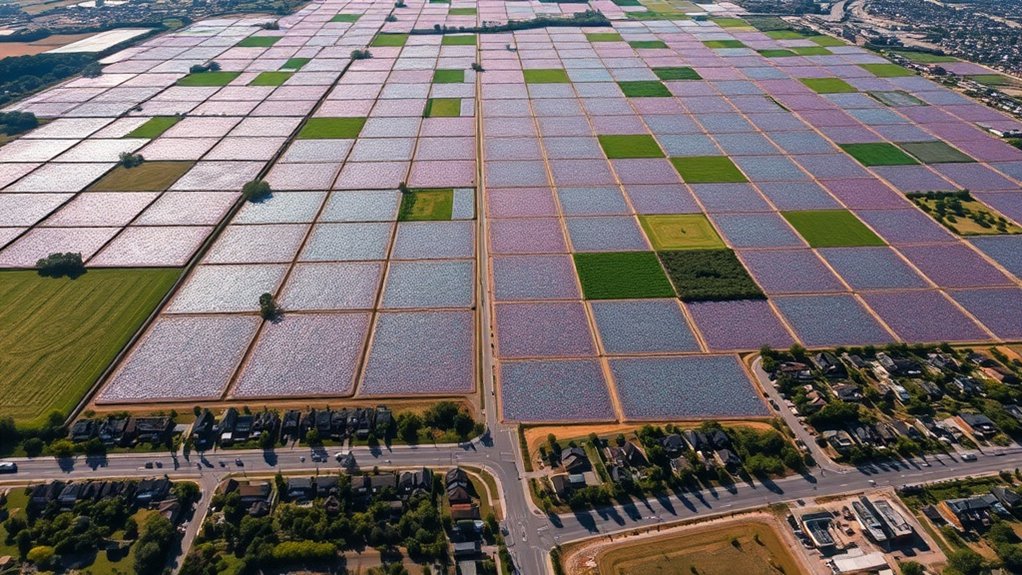
Planning policies for resin-bound gravel vary significantly across UK regions, with each council setting its own guidelines.
Most urban councils favour permeable surfaces to tackle drainage issues, making resin-bound installations an attractive option. In areas like Wigan and Leigh, these systems receive particular encouragement.
If you live in flood-prone regions, you’ll need to meet extra requirements for water management and environmental assessments.
Different rules may apply based on your property type – for instance, listed buildings often face stricter controls than modern homes.
Before starting any installation, it’s vital to check your local council’s specific guidelines.
This early research can save you time and hassle, ensuring your project meets all necessary requirements from the outset.
Assessing Surface Drainage Requirements
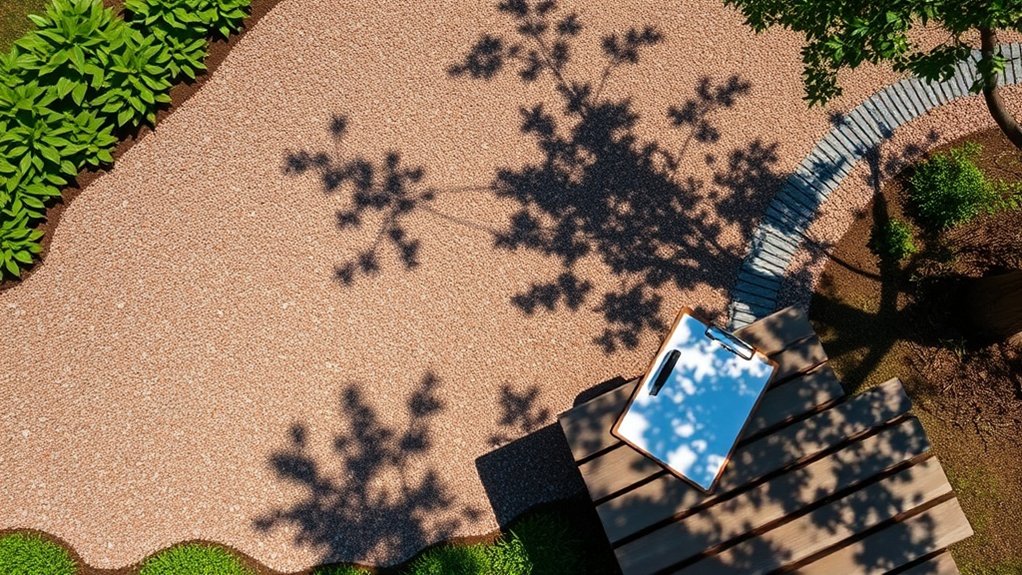
Surface Drainage for Resin-Bound Gravel
A properly installed resin-bound surface needs careful drainage assessment to prevent water pooling. The key is understanding both surface and sub-base permeability. Well-laid resin surfaces naturally support water management and meet SuDS requirements – much like a sponge absorbing rainfall.
For impermeable sub-bases, you’ll need extra drainage solutions, such as channels or soakaways. Think of it as giving water a clear path to escape, rather than letting it collect on your driveway or patio.
| Surface Type | Drainage Requirement |
|---|---|
| Permeable Surface | Minimal to no extra drainage |
| Impermeable Sub-base | Channels/soakaways needed |
| Sloped Installation | Drainage channels essential |
| SuDS Compliant | Cuts runoff, helps local ecology |
This straightforward approach ensures your resin-bound surface meets UK drainage regulations whilst protecting your property from water damage. Most British homeowners find that proper drainage planning saves significant hassle during wet weather.
Installation Best Practices

Essential Steps for Resin-Bound Gravel Installation
Proper installation of resin-bound gravel requires careful attention to four key areas: base preparation, mixing, application and finishing.
First, dig the area to 150mm depth and lay a firm base using 100mm of compacted MOT type 1 or 3 aggregate. This foundation is crucial for preventing future sinking or cracking – much like building a house on solid ground.
For mixing, use a forced-action mixer with a ratio of three parts aggregate to one part resin. Think of it like baking – the right measurements ensure the best results.
When laying the surface, spread the mixture evenly at 15-25mm thickness. Keep an eye on the weather, as temperature affects curing time. A dry, mild day is ideal – similar to choosing the right conditions for painting outdoors.
Protect the newly laid surface while it cures. Much like fresh concrete, it needs time to reach full strength.
Following these steps carefully will create a durable, attractive surface that lasts for years.
Differences Between Resin-Bound and Resin-Bonded Surfaces

The key differences between resin-bound and resin-bonded surfaces are straightforward once you know what to look for.
Resin-bound surfaces mix aggregate with resin before laying, rather like making a cake mixture, creating a smooth, level finish that water can drain through. Think of it as a permeable tarmac alternative for your driveway or garden path.
Resin-bonded surfaces work differently – imagine spreading glue and sprinkling gravel on top. This creates a more traditional gravelled look but can shed stones over time, much like a standard gravel driveway might.
It’s worth noting that resin-bound surfaces need less upkeep and last longer, making them ideal for busy household areas.
When it comes to grip, both options serve different purposes.
Resin-bound surfaces offer reliable traction in most conditions, suitable for paths and driveways.
Resin-bonded surfaces provide extra grip, making them particularly good for steep slopes or areas where additional traction is crucial.
Special Cases for Unique Properties

Special Cases: Unique Property Considerations
Every property brings its own set of challenges for resin-bound gravel installations. Certain situations require extra attention during planning:
Heritage Properties
- Listed buildings and conservation areas need local authority approval
- Colour and style must match existing historical features
- Traditional materials may need incorporating into the design
Flood Risk Areas
- Enhanced drainage systems are crucial
- Must prove installation won’t increase flooding risks
- Sub-base depth often needs increasing to cope with water levels
Problem Ground
- Clay soil requires additional foundation work
- Steep gradients need special edging and reinforcement
- Tree roots nearby mean flexible base materials are essential
Each unique case needs proper assessment before work begins, ensuring your installation meets both legal requirements and practical needs.
Documentation and Compliance Verification

Essential documentation and compliance checks are vital for resin-bound gravel installations across the UK. Gather key paperwork, including SuDS compliance certificates and permeability test results to meet local building regulations.
Keep thorough records of all materials and methods used – much like maintaining a car’s service history. Your local council’s planning department will need proof that your installation meets current drainage and flood prevention standards.
For example, if you’re installing a new driveway in Manchester, you’ll need to show it can handle the region’s heavy rainfall without causing water run-off issues. Skipping these compliance checks could result in costly enforcement notices and mandatory alterations.
Sort your documentation early to avoid headaches later – proper paperwork is as important as the installation itself. Store all records in a dedicated folder, including:
- Material specifications
- Installation photos
- Test certificates
- Planning permissions
- Contractor credentials
Staying Informed on Regulatory Changes

Keeping Up with Resin-Bound Regulations
Tracking changes in resin-bound surfacing regulations is essential for both compliance and quality workmanship. Recent UK legislation has made this particularly important for installers and contractors.
Must-check areas:
- REACH regulations – current focus on diisocyanate handling training
- Local SUDS policies, especially critical in flood-risk areas like Yorkshire and the South East
- Latest FeRFA and BBA updates for industry standards
Missing these updates could mean non-compliant installations and hefty fines.
A practical approach is to set monthly reminders to check the relevant governing bodies’ websites or subscribe to their newsletters.
For best results, maintain a simple checklist of current requirements and review it quarterly with your installation team.
Frequently Asked Questions
Can I Install Resin-Bound Gravel in a Conservation Area?
Resin-bound gravel installations are permitted in conservation areas, but you’ll need to check with your local council first. Most councils welcome this surface type as it’s permeable and maintains the traditional aesthetic that conservation areas require. Simply ensure your chosen contractor follows the area’s specific planning guidelines and installation standards.
What Are the Costs Associated With Obtaining Planning Permission?
Planning permission fees typically range from £206 to £3,000, varying by location and project size within the UK. Additional costs often include architect drawings, surveys and legal consultation. For a typical house extension, expect to budget around £500 for the basic application plus professional fees. Contact your local council’s planning department for specific fee structures in your area.
How Long Does the Planning Permission Process Typically Take?
Planning permission typically takes 8 to 16 weeks in the UK, though timelines vary based on several factors. Simple household projects like extensions might get approval closer to the 8-week mark, whilst complex developments could stretch beyond 16 weeks. Local council workload, the completeness of your application and any objections from neighbours all affect waiting times. Submit thorough, well-prepared documents to avoid delays.
Are There Height Restrictions for Resin-Bound Gravel Installations?
Resin-bound gravel installations don’t have strict height limits, but proper installation depth is crucial for safety and durability. A typical raised edge of 15mm helps contain the resin whilst meeting standard building regulations. For domestic driveways and paths, a depth of 18-20mm usually suffices.
Do I Need Planning Permission for Resin-Bound Surfaces in Front Gardens?
Planning permission isn’t typically required for resin-bound driveways or garden surfaces, provided they’re permeable and meet UK front garden regulations. Think of these surfaces like a sponge – they allow rainwater to soak through rather than create surface run-off. Most councils classify them as permitted development, but it’s worth checking your local authority’s specific guidelines, particularly if you live in a conservation area or listed building.
Conclusion
For large resin-bound gravel installations in the UK, proper planning permission is crucial. Local councils have specific requirements, particularly for areas larger than five square metres where drainage might be affected. Most domestic installations on existing driveways typically don’t need permission, but it’s worth checking with your local authority first.
Key points to consider:
- Front garden installations often need permission due to water runoff concerns
- Commercial projects almost always require formal approval
- SUDs (Sustainable Urban Drainage Systems) compliance is essential
- Listed buildings have additional restrictions
Contact your council’s planning department early to avoid costly mistakes. Many suppliers and installers can help with the paperwork, but ultimately, compliance is the property owner’s responsibility.
